First of all, let’s answer this question that many newbies were asking me: What is Alby Hub?
Alby Hub, is a simple LN node interface, with nice NWC functionalities to connect various LN services and be used “on-the-go”. It is NOT a LN node in itself but is offering tools to manage the LN node behind. Is like LNbits or Zeus.
Yes, I know, Alby team already have a nice documentation page about this, their Github repository is also well documented (from there I was inspired too), but with this mini guide I want to bring this information to more people, especially to my readers that maybe will find a bit complicated to read all those instructions. Also my guide is dedicated to a specific setup, that few are talking about: the advanced mode setup.
Also BTC Sessions made a nice video tutorial, but that one also is taking the simple path of using the Alby Cloud and not the “advanced” path of managing yourself the LN node behind the Alby Hub.
So let’s get started with explaining the modes you can run Alby Hub:
- using Alby Cloud, migrating your existing custodial Alby account
- using a VPS / hosting service with Alby Hub, pointing it to your home /remote LN node
- using a new account, running Alby Hub on your local PC, together with your own LN node. This method also could be run as standalone LN app or as a server, depending on how is your day to day usage.
I was testing (almost) all funding sources for Alby Hub and I will make a classification. I have to mention also that you can run it as a “private node” (not routing) or as a public node (routing) with some more complex steps. In this guide I will talk only about the “private” mode, mode that can be used by all newbies that are not so familiar with the complexities of running a publicly exposed node (domains, SSL certificates, router ports etc).

BASIC REQUIREMENTSBASIC REQUIREMENTS
We consider you are a simple user, that do not have any (desktop) LN node, nothing, just want to run in a self-custodial way a simple LN node for your personal needs and maybe later giving some sub-accounts to your family and friends.
- a simple PC, even with 4 GB RAM, recommended Linux OS. Alby Hub works also on Windows machines, but I will not recommend that.
- some basic knowledge of running some command lines in Linux Terminal. Is just copy/paste in fact.
- a mobile phone to connect Alby Go.
SETUP STEPSSETUP STEPS
STEP 1 - OSSTEP 1 - OS
Install Linux on that PC, I would recommend DebianOS (is more stable, if you want to dedicate that machine only to Alby HUB + LN node), but works on any other Linux distribution, even if you have a normal Linux Mint desktop could work perfectly fine. So use whatever other Linux you like.
STEP 2 - PREPARE ALBY FUNDING SOURCESTEP 2 - PREPARE ALBY FUNDING SOURCE
Start here: https://albyhub.com/ and choose “do it yourself”. Then you will be redirected to login with an existing Alby account (if you want to migrate it to self-custodial) or create a new one, to start a separate one with your new self-custodial instance.
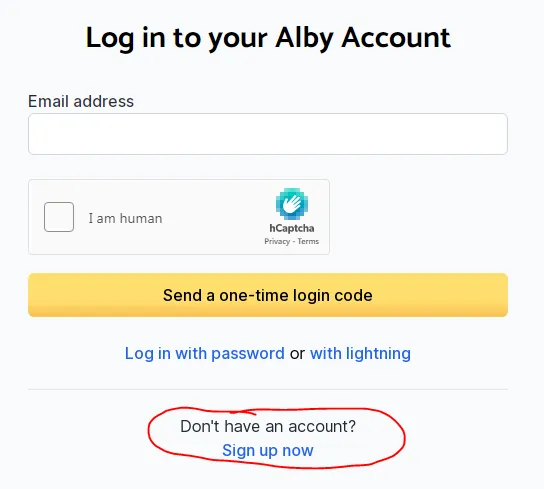
Just create a new one and you will get an invitation code for running your Alby Hub.
Go to “Desktop setup” instructions and download the executable file for the OS you are using. No need to install anything, just run the executable file.
Once you start Alby Hub app, you will be prompted to input an invitation code. If you already have an Alby account (custodial) you can get it from there, but remember that you will migrate everything to your new self-hosted Alby Hub. I would suggest to start with a new Alby registration and once you are asked what type of account you want you can choose self-hosted and get that invitation code, that later you will have to input in the setup of your Alby Hub. Later you can change or personalize the LN address and even use your own domain for that.
Alby Hub is offering a variety of funding sources that you can choose first time you start it. A very easy to use GUI interface, that help you to connect instantly with your LN node behind (funding source).
Reminder: We are talking here ONLY about using the “private node” mode, not public.
Once you start Alby Hub, you will be prompted with this screen, where you have to choose “Advanced setup” if you do not want to use the Alby Cloud option:
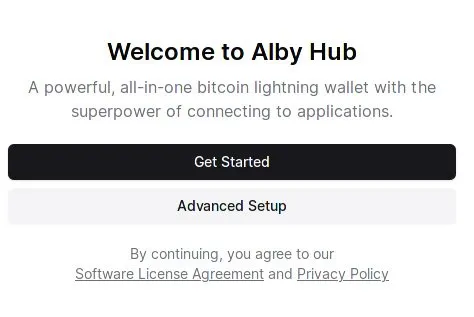
Then you will be prompted to choose one of the backend funding source:
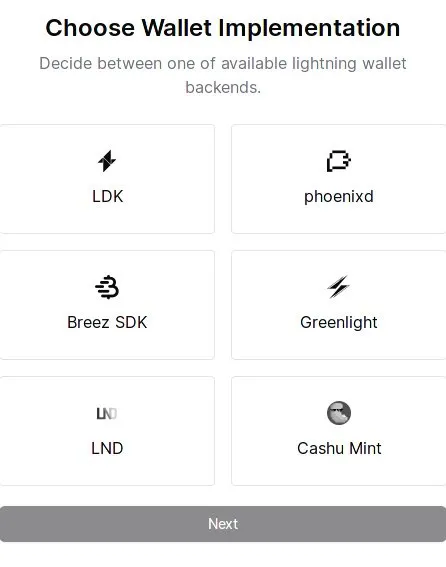
LDKLDK
The simplest one and straight forward. If you choose that one, it will install automatically a LDK node instance and start right away, going to open one or many channels with the LSPs offered or any other node peer you like. LDK will not use so many resources, being a lightweight LN implementation. Also do not need to run beside a full bitcoin core node, it uses public Esplora servers. If you want to run your personal Esplora server, you have that option too, but you need to dig more into CLI configurations.
PhoenixdPhoenixd
Another simple and straight forward funding source for Alby Hub. Only that this one will use the “walled garden” liquidity from Acinq and will charge the 1% fees for that. If you do not want to deal with channels node management, this is a perfect solution.
Installation of phoenixd is quite simple, just follow these simple command lines: https://phoenix.acinq.co/server/get-started
Once phoneixd is up and running go to Alby Hub and input the required authorization code for that local server:

LNDLND
A more complex and robust funding source, that require previous installation before you want to link it to your Alby Hub. Would be nice if Alby team will include an automated installation of LND like the LDK.
What I would recommend is to install a LND instance in “neutrino mode” on the same machine where are you going to run Alby Hub. In this way you do not require to run also a heavy bitcoin core node, with full blocks that will eat up almost all the machine resources. And don’t worry, the “neutrino mode” is not a “privacy concern”, neutrino is only delivering blocks data filters, do not read any xpub or addresses, IPs etc. It is used also by Zeus (embedded), Blixt, Breez.
Installing lnd from source:
With the preliminary steps completed, to install lnd, lncli, and all related dependencies run the following commands:
git clone https://github.com/lightningnetwork/lnd
cd lnd
make installThe command above will install the current master branch of lnd. If you wish to install a tagged release of lnd (as the master branch can at times be unstable), then visit the release page to locate the latest release. Assuming the name of the release is v0.x.x, then you can compile this release from source with a small modification to the above command:
git clone https://github.com/lightningnetwork/lnd
cd lnd
git checkout v0.x.x
make installFor more details about installing and configuring LND instance please read here.
In that document you will also find the following lnd.conf configuration for neutrino mode:
bitcoin.node=neutrino
feeurl=https://nodes.lightning.computer/fees/v1/btc-fee-estimates.jsonOnce the LND is up and running, continue with backing the macaroons and TLS certificate required to connect Alby Hub, those will be necessary in this next step:
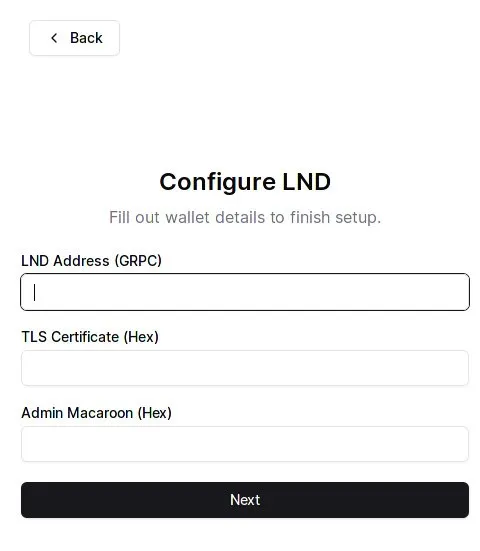
LND address - your local LND instance, eg. http:/127.0.0.1:9735
TLS Certificate - path to the LND TLS cert file, usually in lnd/data
Admin Macaroon - your backed admin macaroon to authorize the connection
Cashu MintCashu Mint
An interesting and damn simple connection as funding source. If you do not want to deal with all above LN nodes, channels management liquidity etc. this is one of the most straight forward and simple solutions.
YES, is custodial, but if you deal with small amounts, only for donations, nostr zaps, small payments etc, this is enough.

By default is offering the Minibits.cash mint, but you can use whatever other mint you like (see more here: https://bitcoinmints.com/ ), or your own mint if you run one.
The only concerning part with this funding source is that there’s no way to have backup the tokens or keys for this funding source. Not yet, I am sure the Alby team is working on that. So if your Alby Hub get busted, you do not have a backup of the funds (or I couldn’t find it myself until now).
Greenlight / Breez SDKGreenlight / Breez SDK
This is a Greenlight funding source method, based on invitation code and a Breez API key. You can request them here. Greenlight is a “Lightning-as-a-service” node, where the user hold the keys but do not manage the channels liquidity and the server.
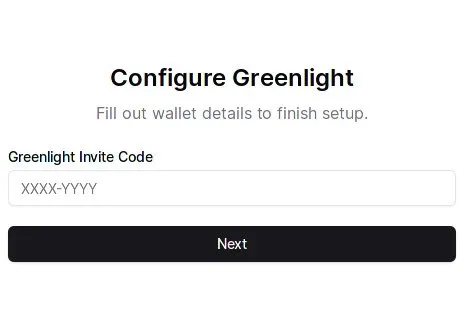
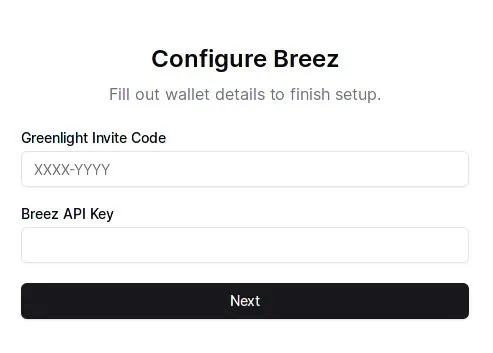
STEP 3 - START USING YOUR ALBY HUBSTEP 3 - START USING YOUR ALBY HUB
Aaaand that’s it! Once you connect a funding source, you are ready to go and use your Alby Hub, connecting it to various LN apps with NWC, connecting to Alby Go as a mobile wallet, create limited accounts or even act as “uncle Jim” with the special deployment of “Alby Jim”.
The variety of apps connections is incredible and easy to setup with provided instructions in the interface.
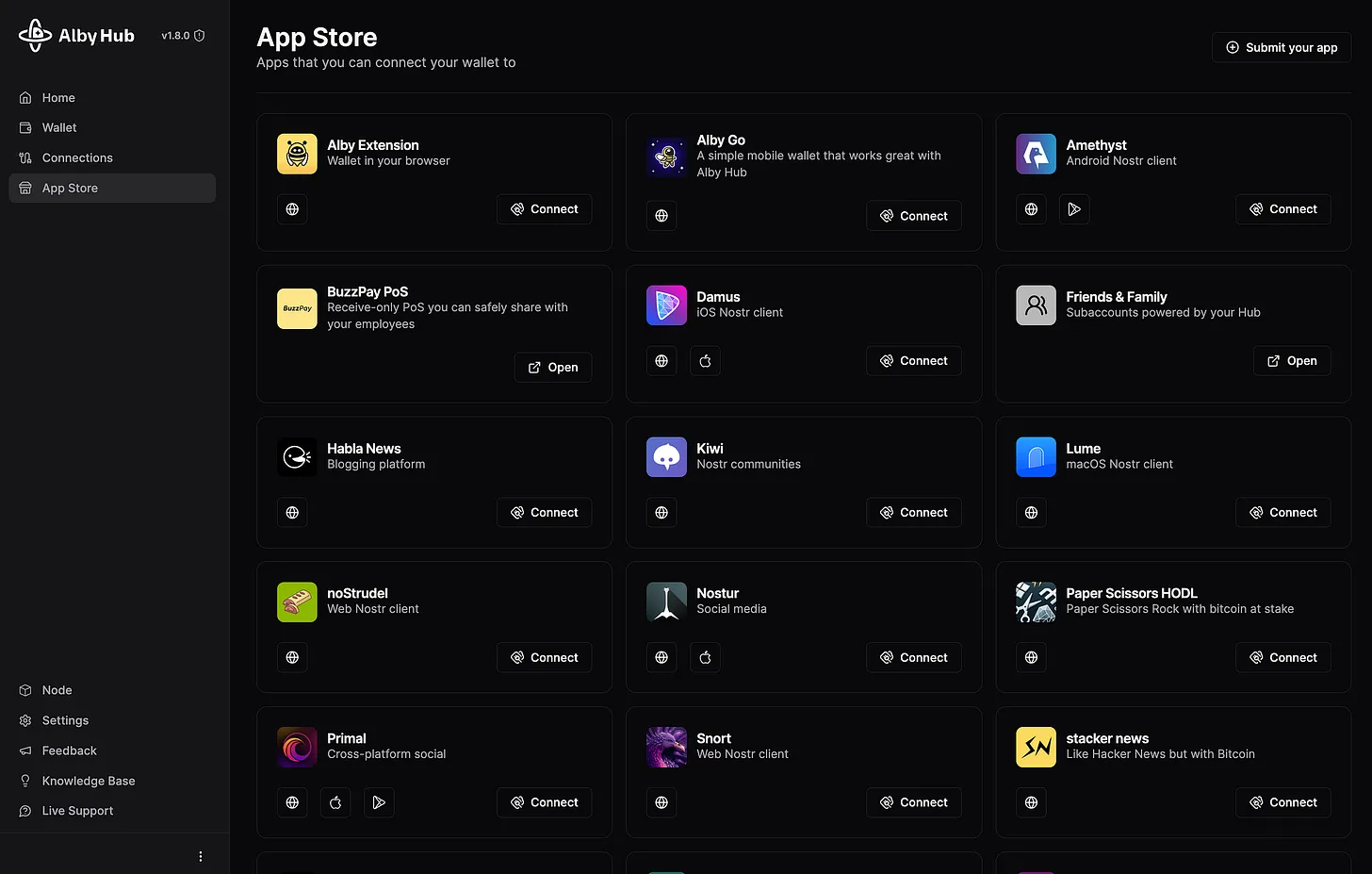
MORE RESOURCES:MORE RESOURCES:
- Deploy it yourself - Alby Github instructions if you want to run it as server
- A very nice guide about configuring and connecting Alby Hub to Stacker News account - by our fellow stacker @supratic
- Run your Alby Hub with Nodana (hosting service)
- Run your Alby Hub with Alby Cloud (hosting service)
ENJOY LIGHTNING NETWORK!
I am unable to create an account without an invite code. Does anybody have one I can use?
Once you create a new account with an email, you will get that code.
Nobody have to give you any other invitation.
When I click sign up now I am met with this page and can’t submit my name and email without a invite code
Strange why worked for me without invite code?
Try these: #660901
uncle jim
#701502
oh I've missed that guide...
Great guide. I just set everything up. Pretty cool to be able to zap someone with having a zero balance on SN.
I have a question about fees. I set up alby hub with LDK backend, opened a channel with 1 million sats inbound liquidity for 16416 sats and sent 10k sats with a 24 sat lightning network fee to it. But I ended up with only 9,644 sats in my balance. Where did the other 356 sats go?
send me a SN DM with your LN address of that hub and I will send you 210 sats for a test.
I had the same thing with LDK, but after I made that payment I received back the 365 sats.
I really don't know the logic of this.
Must be some opening channel scripts from the LSP side.
I guess it's the 354 sats channel reserve for Megalith channels. You can see it on the "Node" page inside Alby Hub.
Can someone explain, If I would run a alby hub for a business as a client, what would be the best funding source that has automated channel management and lowest fees, lets say between phoenixd, breez and greenlight?
LN fees are not defined by each LN implementation, are defined by the routing nodes, the routes taken.
Ok, I meant the 1% from Acinq for example.
That could be nothing if you compare it with all the hassle of managing (opening/closing) several channels that sometimes can get force closed, high fees charged by some routing nodes.
You should run first a routing node for at least a year and keep track of all your expenses with managing it and run also in parallel a node with phoenixd to compare the costs.
Maybe 1% looks scary at first glance, but if you do not know how to manage properly LN channels with another LN implementation, you can end up paying more. It's all about your skills and knowledge.
You are right, the 1% fee is a small price to pay compared to the hassle. Running a routing node and a phoenixd node in parallel is a great idea, also to get some exp. Thanks for sharing your insight.
I wrote several guides about nodes, LN and stuff like that.
I suggest to read them first: https://darth-coin.github.io/nodes/nodes.html
Especially these 2:
I was thinking to test between, Alby Hub (LND), Phoenixd and Lightning.Pub + Shockwallet,
just started testing Pub and looks very promissing but most of the node running is abstracted.
LN.pub + Shock wallet are great. But unfortunately for a total noob will not be so easy to start. I think it require some level of knowledge about how a LN node works.
For a simple LN user, using Shock wallet as a client from an "uncle Jim" node, is great and easy and you can even manage multiple accounts in the same UI. Same as using Alby Go but without multi-accounts.
Learn how to attach phoenixd to SN #695912
How do backups work beyond the 24 words with channel states etc... How can I test restoring the node on another device?
Good question. Alby Hub provide only a migration procedure here
I would suggest to do a SCB backup separately if you use LND.
For the LDK, follow these instructions:
https://guides.getalby.com/user-guide/v/alby-account-and-browser-extension/alby-hub/backups#id-2.-channel-backups
You did it! Thanks. I'm sure I speak for everyone.
Is not so detailed as I would like to be, but at least is giving the directions for all the options you have a s new user. Yes, if you want to go for LND backend, you must do more steps and installations, but I didn't wanted to convert this guide into a LND installation guide.
I would like to see that @Alby team will make the installation of LND and phoenixd in automated mode, when is chosen, like the LDK one. So the user do not have to deal with all those additional steps. In that moment any not so experienced user will have to do just few clicks and his node is up and running.
I've tested various backend funding sources and the LDK is the simplest one and still powerful. The user do not have to do almost anything, just click "next" and then open at least a channel.
@bumi worked on this for Phoenixd (https://github.com/getAlby/hub/blob/master/scripts/linux-x86_64/phoenixd/README.md) and there is also a dedicated Alby Hub Phoenixd for Umbrel. For LND, this is already the case for Umbrel and Start9 and is the default install. Start9 will also support picking between LND and LDK at startup without having to configure anything else.
But yes, we would recommend the default backend (LDK) for most people unless they already have a lightning node.
I can just speak for myself, but I really like the way you started by explaining exactly what the Alby Hub is. I have been using it for weeks, yet I still wasn't quite sure how to describe it.
Yes I got that question from many people and many had the impression that is another standalone LN node. I don't know why they have that in mind.
Alby Hub do not work without a LN backend node, but can "act like one" with a simple UI.
What pleasant surprised me was the connection with Alby Go. So damn simple and fast.
Yes, and the graphics are so big! You can see it easily even when paying a bar tab when you're a little drunk! One thing I was worried about was the big fiat and btc balance fonts. Somebody looking over your shoulder. I messaged them. They said you can change permissions in the NWC connect so the app doesn't know balances.
Thanks Darth
This is gonna be super helpful for me and for many many others.
I think Alby team, with this approach of offering different LN backend options, by levels of complexity, hit a good point where other solutions didn't get it very well.
The easiest of just starting the app and choose a different funding source, from the easiest and automated, through a custodial one (cashu), with a simple line installation of phoenixd and up until complex LND installation is offering all kind of flavors.
Now, nocoiners do not have more excuses not to run a self-custodial node, on any PC, no need to complex machines. Even with LND, as I explained, I've test it in neutrino mode, that works perfectly fine on any machine.
Nocoiners shouldn't have any excuse even without Alby. From smaller payments, the custodial wallets like Blink also work fine.
Thanks Darthcoin.
It'll help me become sovereign as I don't have to depend on my brother for learning about setting up my first, no second but first non custodial wallet.
I'm wondering why you even need Alby Hub if you already have a back- end like Phoenixd or LND.
We are talking about experienced node operators or limited end users?
NWC connections are really cool in this case and Alby is offering a simple UI for those backends.
Not everybody should run Alby Hub and not everybody should run phoenixd or LND...
I think Alby Hub is just offering all flavors for all tastes.
I guess it would be worth setting up Alby Hub if that's the best way to configure Nostr Wallet Connect. Do all of the back-end nodes support NWC?
I don't think is about support for NWC by the backends. NWC is something built on top of any node and do not require any specific code for the LN implementation in order to be supported.
Is more about the easy way for a newbie to get a working NWC wallet for his nostr zaps and many other LN apps out there.
Alby wanted to get rid of the custodial accounts used by all these noobs and I think that this Alby Hub come to help them all to get rid of custodial accounts, but also offering more expanded options with different backends.
They could easily just integrated LDK or even Greenlight and the user not even had to do all the setups. Will be just click-and-play and that's it.
But instead of that, they choose to offer more options and that is excellent choice IMHO.
NWC is actually a big part of Alby Hub, not just for the self-custodial aspect but the idea of seamlessly connecting your node to all your apps you use. "Bring your own wallet" to many apps, similar to the "Bring your own client" idea we see in Nostr and Podcasting.
We are seeing a trend over time that more and more apps are integrating lightning, and rather than having separate inbuilt wallets per app, we see the ability for apps to seamlessly connect to your wallet as a superpower.
Soon Alby Hub will show more stats about usage across apps - for example in the transaction list you can already see what apps make what payments. Alby Hub will really show what is possible with open source programmable money.
Using nostr as a 3rd layer is not just for connecting apps, just check on lightning.pub, they implemented a bolt12 like feature without using the native bolt12 implementation but using nostr relays to act as a middleman to deal with it, very interesting combination of technologies.
Now I've completely set it up. So relieved. Thank you so much. Great guide!
send me a SN DM with your LN address of that hub and I will send you 210 sats.
I've not attached it with my SN wallet so far. As soon as I do I'll send.
it doesn't matter if is linked or not to SN. I am not sending to your SN, I will send to your Alby Hub directly. Is just to test your setup and I will send from another source not SN. If you want.
Thank you so much sir for making such a simple step by step guide.
Excellent guide, as always. I have two questions, if anybody could help me:
Yes, what's the difference between them, for what would I choose one or the other
executable = you start it only when you want to use it
server = is up running all the time as a system service.
both do the same thing, but do not start the same.
ok, I was about to make an ugly systemd service for nothing I see haha. Thx darth
Money is a lil tight so I'm wondering, what's the most cost-effective way to go about this? I generally leave my PC on all the time but if I leave to travel I like to turn it off, at which point it wouldn't make for a good setup if I want to still be able to use Alby Go on my travels. Cloud hosting seems like my best bet but is going directly through Alby Cloud the most cost-effective or are there other, cheaper options that will work as reliably/be secure?
Good question.
If you do not want to run with the self executable, as any regular app indeed you can go for Alby Cloud, the easiest way.
Other options will be:
This is a great guide. Just set it up with LDK. Couldn't figure out how to connect it to my existing alby browser extension yet.
you just have to click on that icon and done

Well, If you use default setup (LDK) then it is a lightning node, isn't it?
Nice guide though Darth!
Just followed your guide and created this account using my self-hosted Albyhub! thanks.
send me a SN DM with your LN address of that hub and I will send you 210 sats.
It looks like an easy to use version of LNBits, especially the friends and family extension is super handy to become an uncle Jim, thanks Darth and well done Alby
yes, only that LNbits is more advanced stuff. This one any newbie can run it.
Amazing! Much impressive and thoughtful guide, thanks
I see that at the beginning it says that I can migrate... I mean, if I already had an account in Alby with its custody service which I also use to enter Nostr. Now I just have to migrate to Alby Hub.
Or will that account and that channel that I used simply cease to exist, and I have to create everything from the beginning? @DarthCoin
Yes you can migrate it. But I would recommend to create a new one, cost nothing.
Ok, thank you very much for your prompt response! I will take your recommendation and create a new one.
Justice for 80 IQ Windows pleb users🤣🤣
80?! Is too much.
Seriously now, you have to be really dumb to use windoze nowadays, just as a normal user.
I understand those devs that are forced to use windoze for their work, with a controlled environment (win Server etc), but as a regular user, just for internet, email and bitcoin you are really fucked up using windoze.
A simple Linux Mint is waaaay more robust and safe than any stupid Win 11 on a laptop.
Very well-written guide. Thanks for going in depth on the multiple backends. For me just containing everything to what the default offers is enough for me, but I'm glad to see there's quite a bit of flexibility out of the box.
Thanks! I'm going to set up Alby HUB this weekend, your guide will be helpful.
bookmarked. Thanks Darthcoin
Thank you DC!
Zaps are deserved :)
Hit us up with any questions about the Hub!